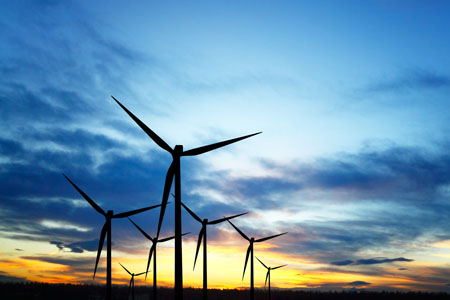
The Department of Energy (DOE) 2014 Wind Technologies Market Report shows that total installed wind power capacity in the United States grew at a rate of 8 percent in 2014, bringing the United States total installed capacity to nearly 66 GW.
The U.S. wind fleet is second largest in the world and meets 4.9 percent of U.S. end-use electricity demand in an average year. In total, 4,854 MW of new wind energy capacity were installed in the United States in 2014. DOE released the wind report documents on Aug. 10.
The 2014 Wind Technologies Market Report also finds that wind energy prices are at an all-time low and are competitive with wholesale power prices and traditional power sources across many areas of the country.
Additionally, a new trend identified by the 2014 Wind Technologies Market Report shows utility-scale turbines with larger rotors designed for lower wind speeds were increasingly deployed across the country in 2014.
The U.S. wind industry has had a ripple effect on the American economy, supporting 73,000 jobs related to development, siting, manufacturing, transportation, and other industries, according to the report.
Wind power capacity additions across the nation rebounded in 2014, and continued growth through 2016 is anticipated. Recent and projected near-term growth is supported by the industry’s primary federal incentive—the production tax credit (PTC)—which is available for projects that began construction by the end of 2014. Wind additions are also being driven by recent improvements in the cost and performance of wind power technologies.
Growing corporate demand for wind energy and state-level policies play important roles as well. Expectations for continued technological advancements and cost reductions may further boost future growth.
“At the same time, the prospects for growth beyond 2016 are uncertain,” according to the report’s executive summary. “The PTC has expired, and its renewal remains in question. Continued low natural gas prices, modest electricity demand growth, and limited near-term demand from state renewables portfolio standards (RPS) have also put a damper on growth expectations.”
Wind power represented 24% of electric-generating capacity additions in 2014. The United States ranked third in annual wind additions in 2014, but was well behind the market leaders in wind energy penetration. Global wind additions reached a new high in 2014, with cumulative capacity standing at 372,000 MW. The United States remained the second leading market in terms of cumulative capacity, but was the leading country in terms of wind power production.
A number of countries have achieved high levels of wind penetration: end-of-2014 wind power is estimated to supply the equivalent of roughly 39 percent of Denmark’s electricity demand and more than 20 percent of Ireland, Portugal, and Spain’s demand. In the United States, the wind power capacity installed by the end of 2014 is estimated, in an average year, to equate to 4.9 percent of electricity demand.
Texas installed the most capacity in 2014 with 1,811 MW, while nine states exceed 12 percent wind energy penetration. New utility-scale wind turbines were installed in nineteen states in 2014, according to the DOE report.
Independent power producers (IPPs) own 3,572 MW, or 74%, of the 4,854 MW of new wind capacity installed in the United States in 2014. Nearly all of the remaining 26 percent is owned by investor-owned utilities (IOUs), led by MidAmerican Energy (3 projects totaling 511 MW), Portland General Electric (267 MW), Minnesota Power (205 MW), Detroit Edison (2 projects totaling 187 MW), and Consumers Energy (111 MW).

